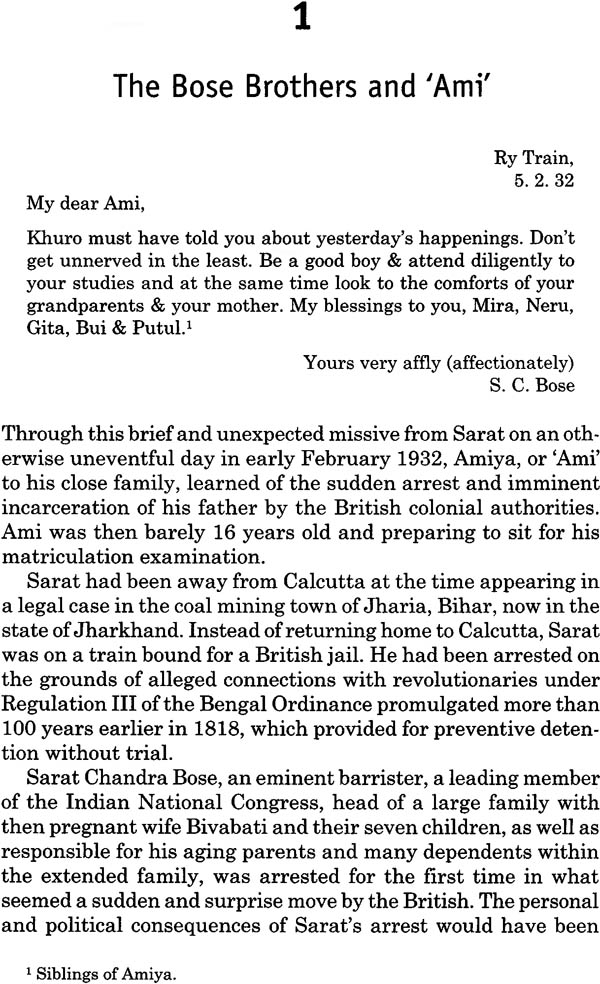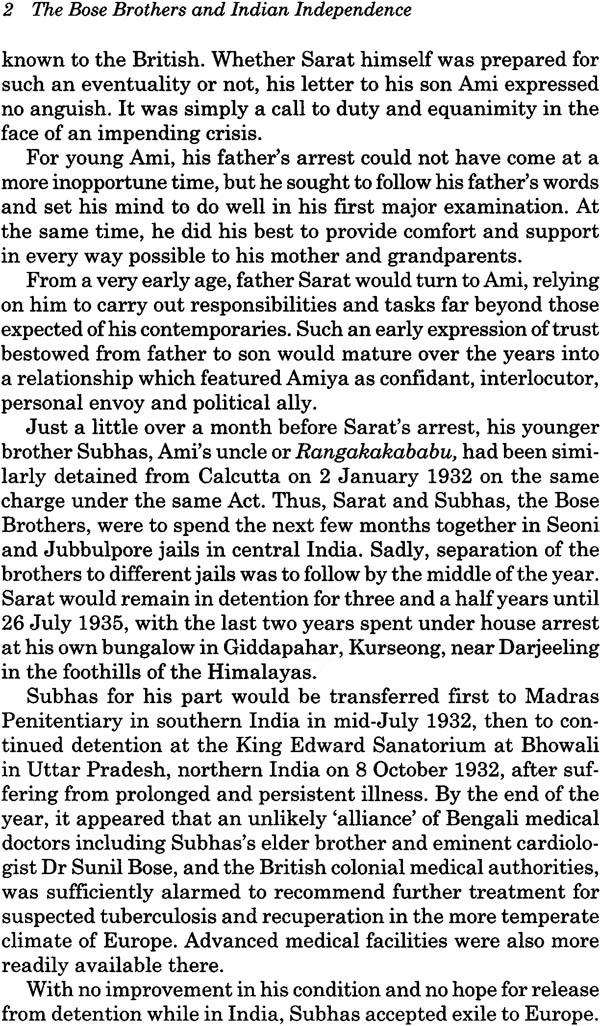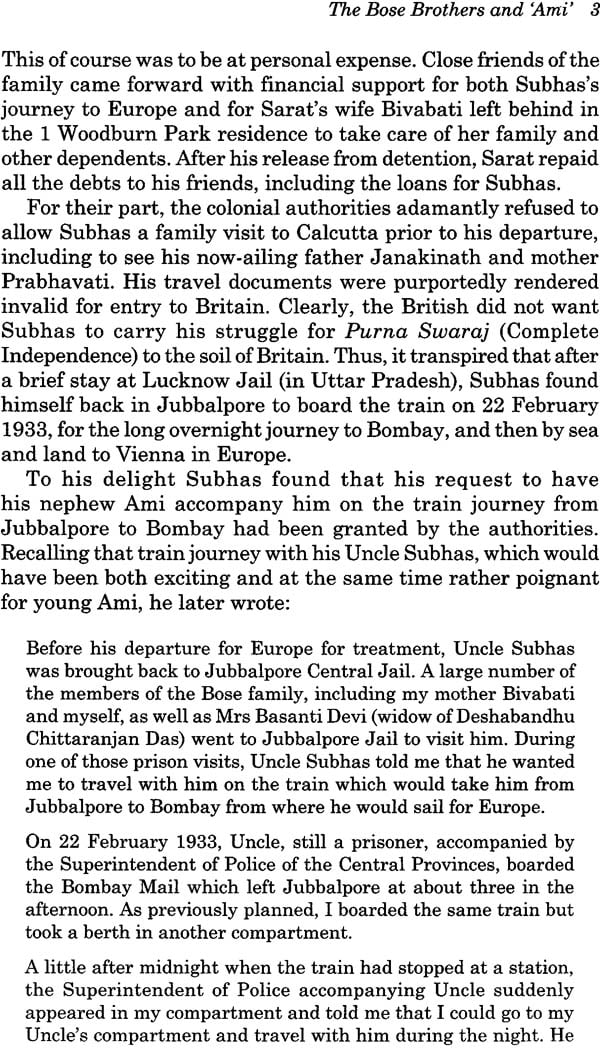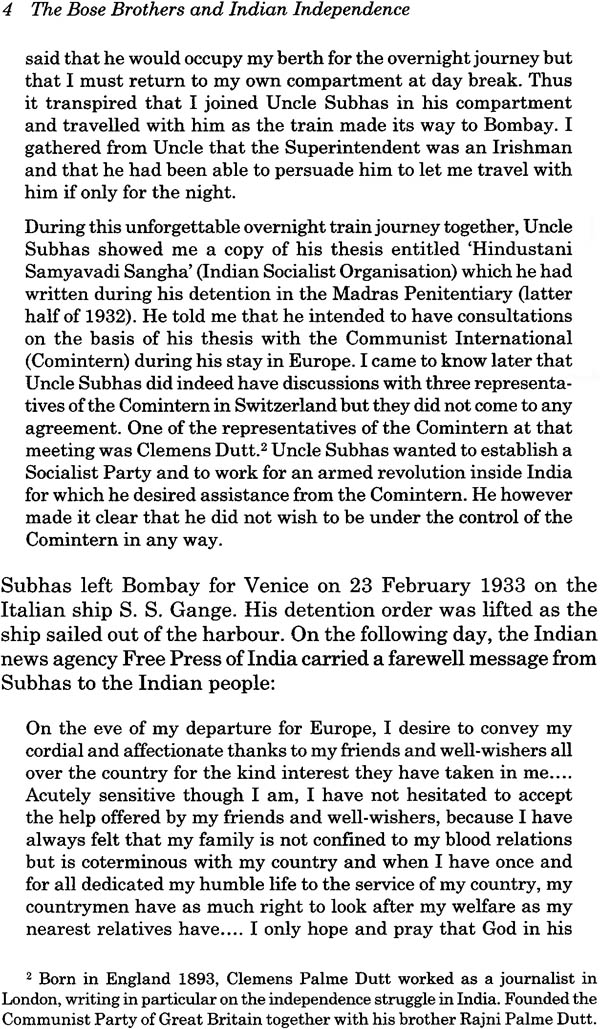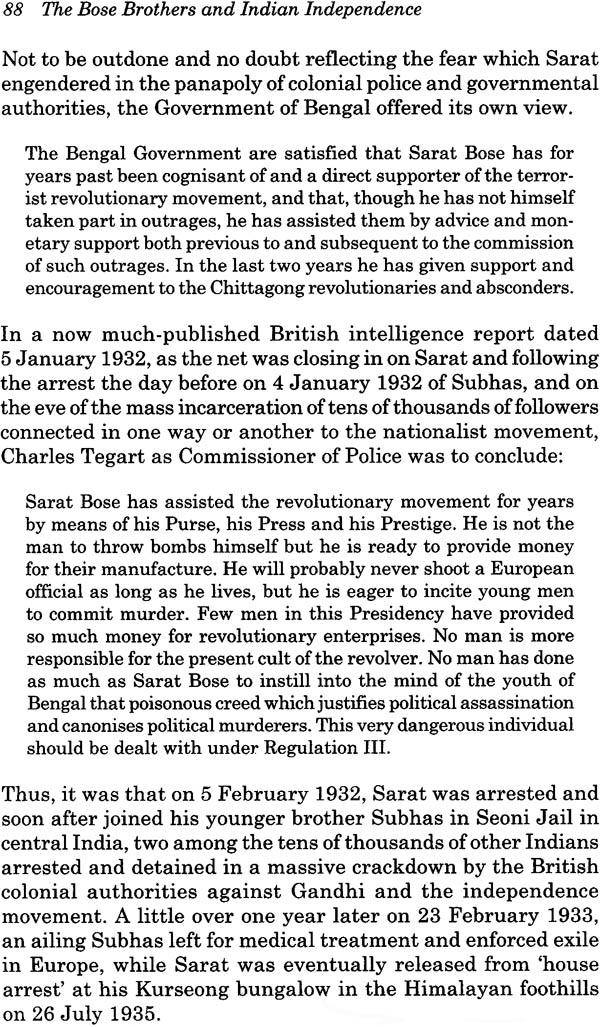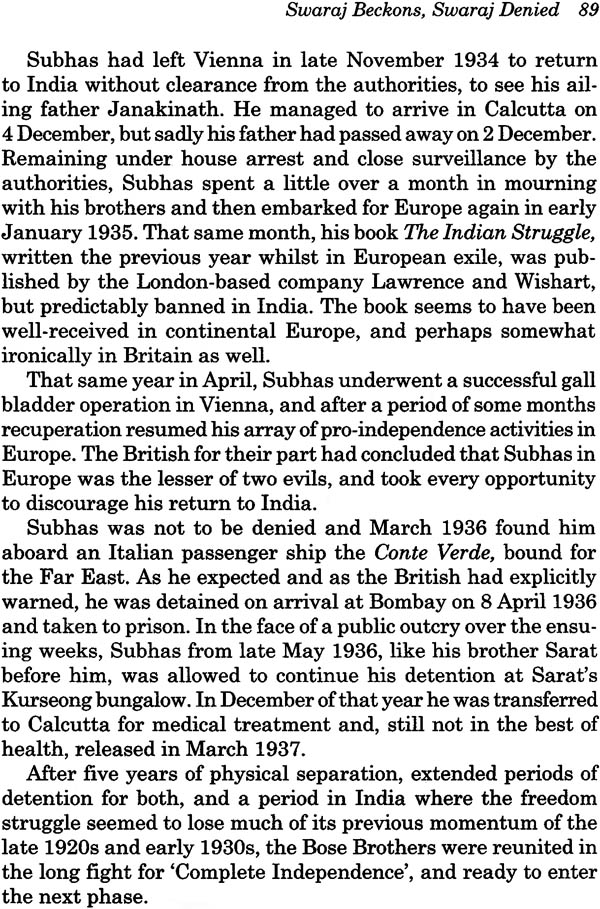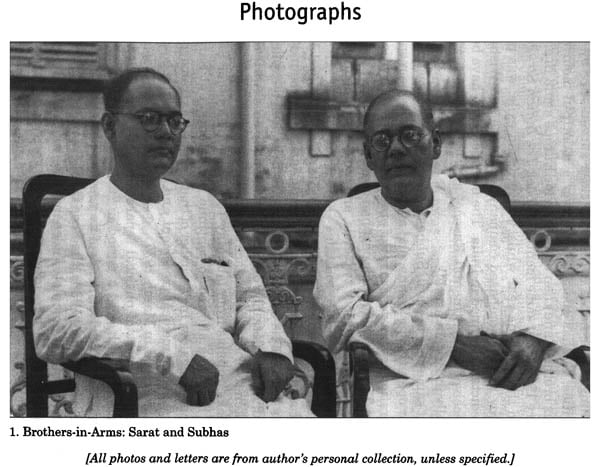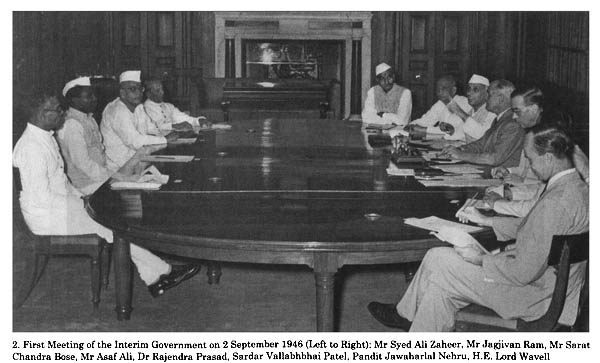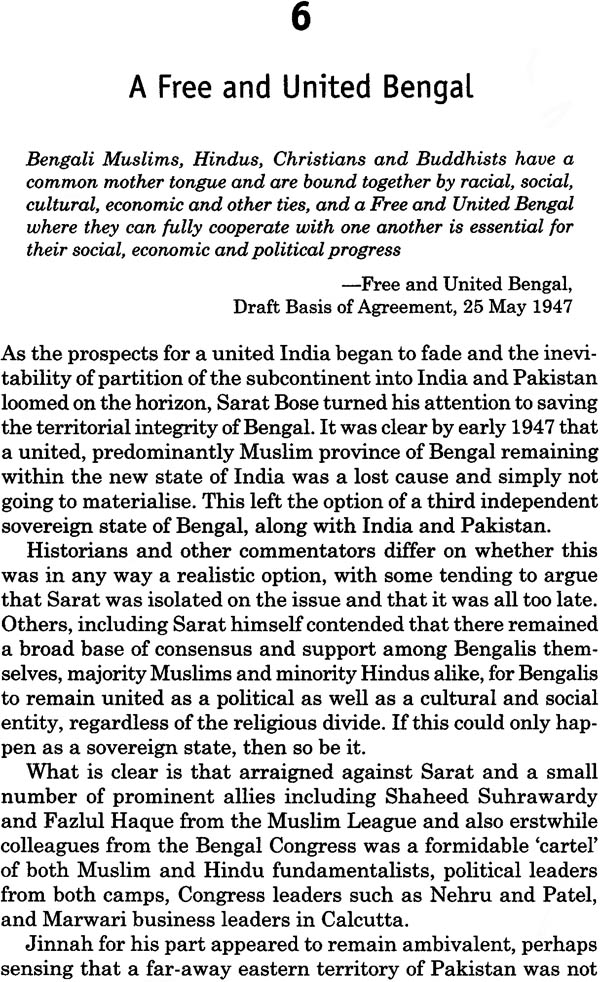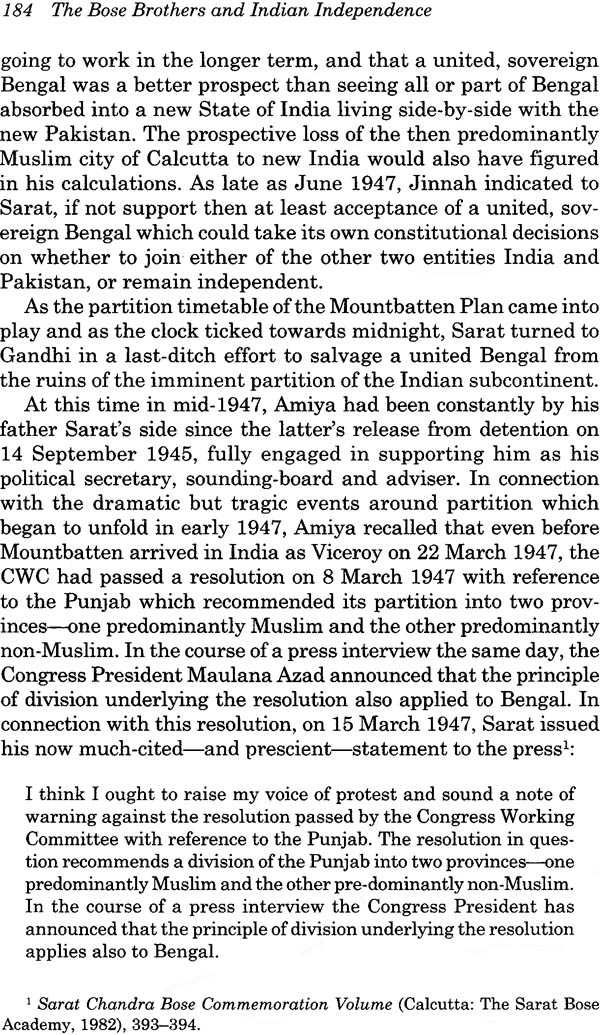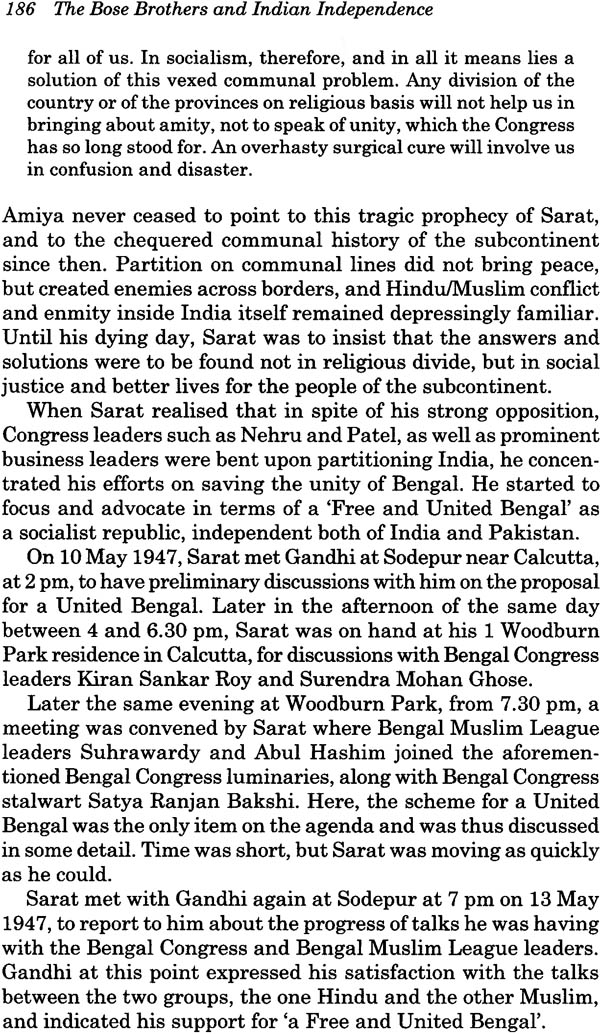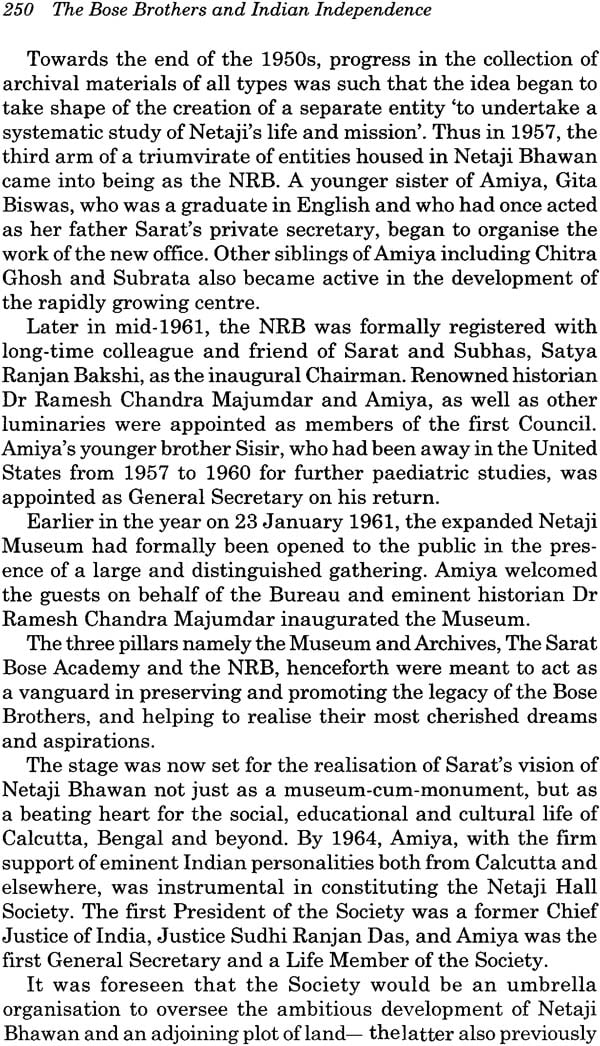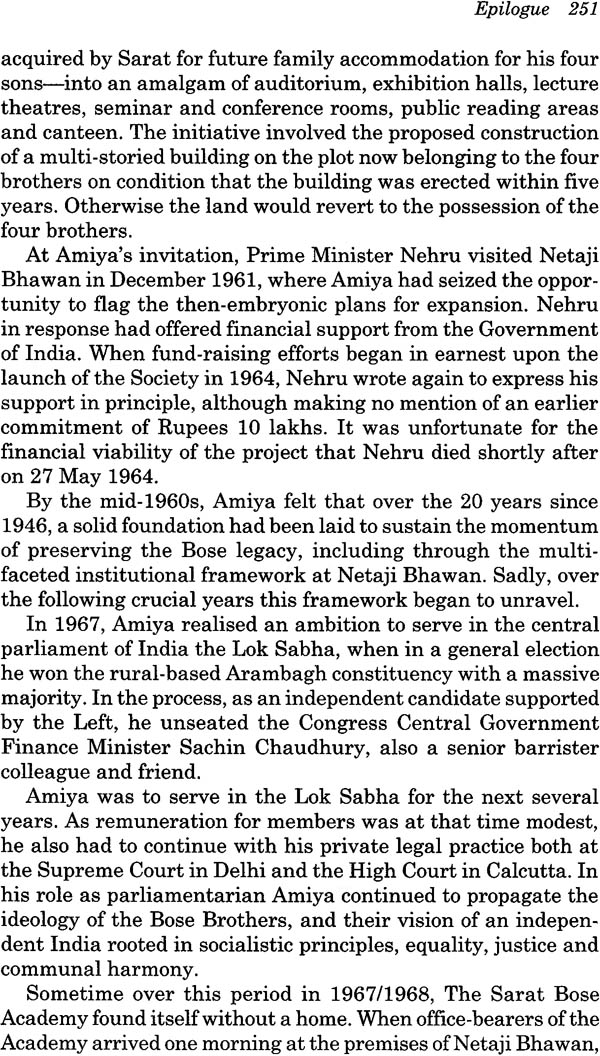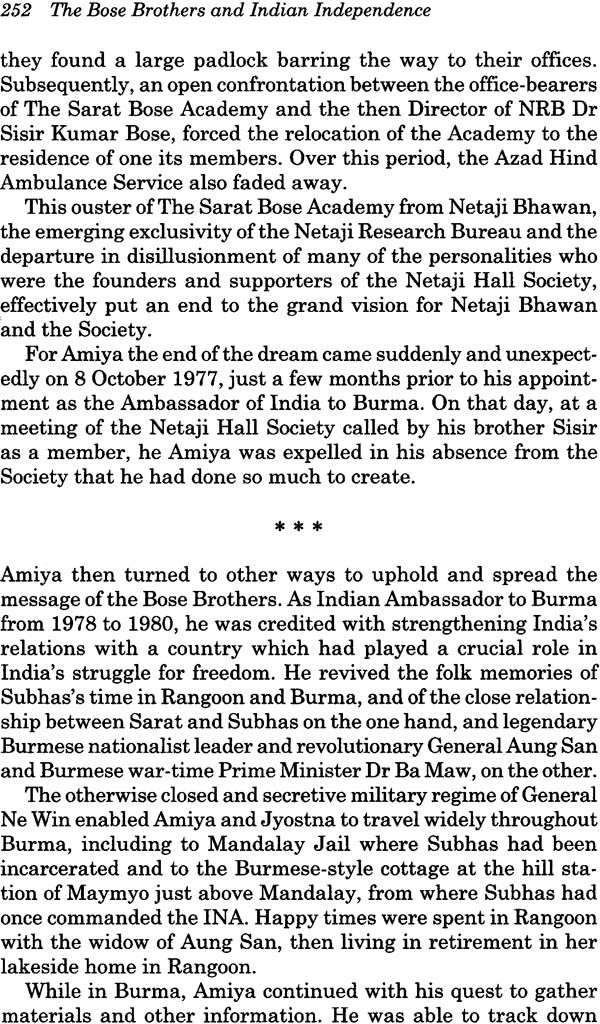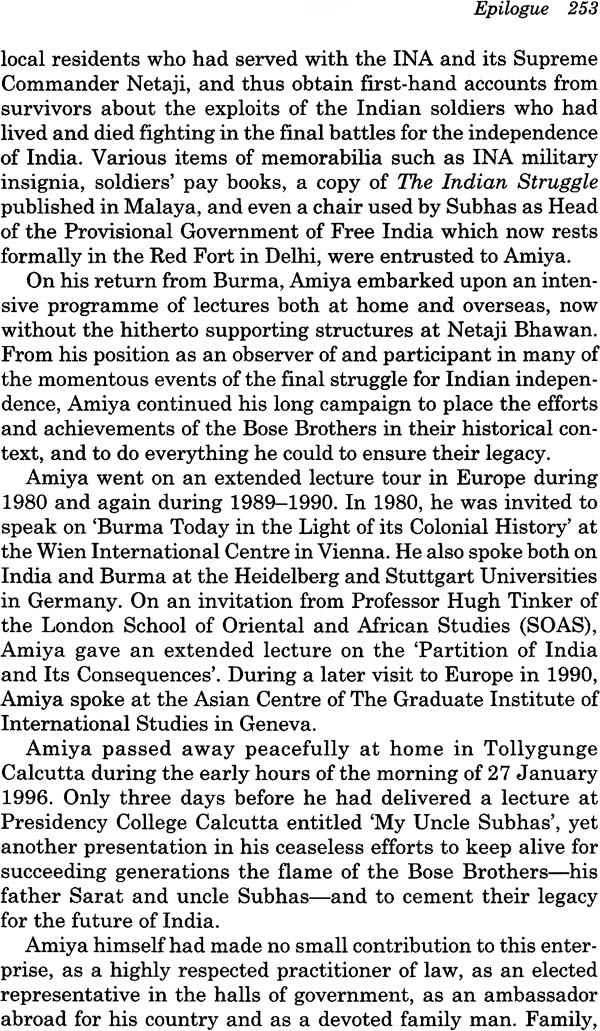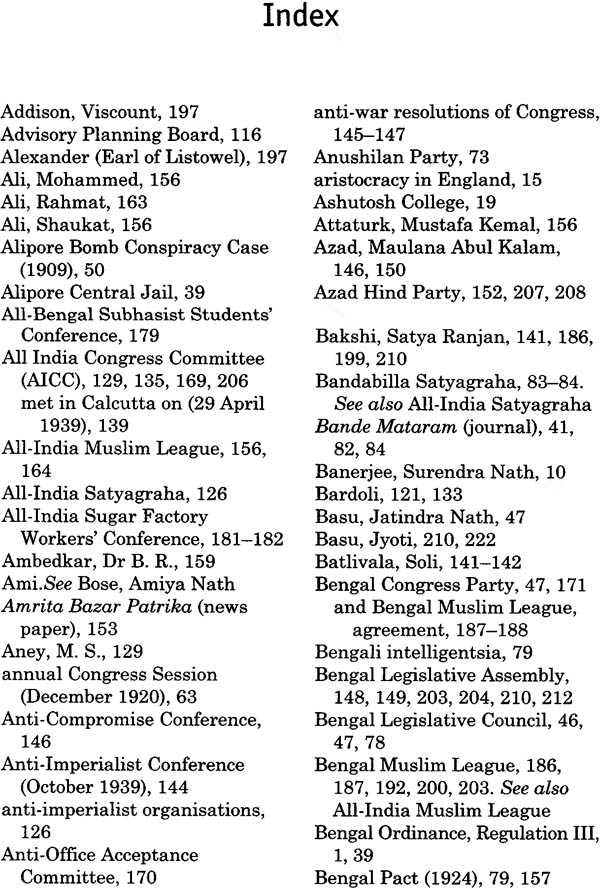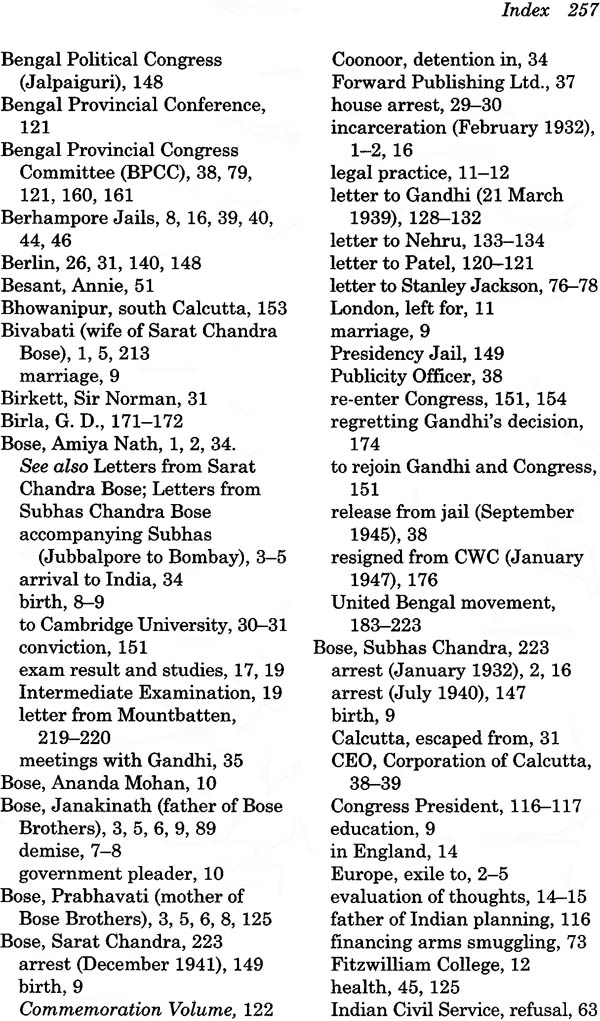
The Bose Brothers and Indian Independence (An Insider's Account)
Book Specification
| Item Code: | NAL983 |
| Author: | Madhuri Bose |
| Publisher: | Sage Publications India Pvt. Ltd. |
| Language: | English |
| Edition: | 2016 |
| ISBN: | 9789351503972 |
| Pages: | 298 (30 B/W Illustrations) |
| Cover: | Hardcover |
| Other Details | 8.5 inch X 5.5 inch |
| Weight | 450 gm |
Book Description
This book chronicles the roles of Sarat and Subhas Chandra Bose in the Indian freedom struggle. It draws from first-hand accounts of Amiya Nath Bose who was close to them as family, political ally and also was a confidant and trusted envoy.
Madhuri Bose was born and grew up in Kolkata. She is the daughter and second child of Amiya Nath and Jyostna Bose, granddaughter of Sarat Chandra Bose and grandniece of his younger brother Subhas Chandra Bose. Reminiscences from her father Amiya of the immense contribution of the iconic Bose Brother to the Indian freedom struggle were the stuff of her childhood and the genesis of this book.
After graduate and post-graduate studies in the University of Calcutta and Jadavpur University, Madhuri undertook post-graduate research at the Graduate Institute of International Studies in Geneva, Switzerland. She has pursued her professional career as a human rights advocate for over more than three decades with the International Labour Organisation, Geneva; the United Nations Development Programme, East Africa; and the Commonwealth Secretariat in Lomdon. In her professional capacity, Madhuri has written extensively on human rights issues and has travelled widely in Africa, Asia and Europe.
This illuminating book is an important addition to the literature on India’s freedom movement and the roles in it the formidable Bose Brothers, Sarat and Sunhas. It is also extremely readable, not many will put it down midway.
The portraits on which this book sheds light are intimate ones, though the word ‘interior’ may be more apt. Here we are offered, among other things, the inner thoughts of Subhas Bose in his 20s, 30s and early 40s, communicated to a brother older by eight years and also to the brother’s son Amiya Nath, 17 years junior to Subhas and devoted to his uncle.
Clearly Subhas nursed high expectations from Amiya Nath. In one significant letter written in 1933, he asks his nephew, then 18 years old, to seek ‘the loftiest heights’ and explains how he can be do it. He should work but aim ‘to serve others and die for others’ Arrogance, Subhas adds was ‘a great sin’; a really great person is self- confident but arrogance-free. Moreover, life’s key principle ‘is to give and not to take’. Those who are mean to us can be conquered by love.
This remarkable advice was also a challenge to which, it must be said, Amiya Nath rose manfully. Like father Sarat, and gradfather Janakina Bose, Amiya Nath became a successful lawyer. Bold, self-confident and dedicated to his country’s liberty, he spent most of the Second World War years in England, from where he remained in secret contact with Uncle Subhas, who was in Germany from April 1941 to February 1943.
Some years after independence, Amiya Nath entered the Lok Sabha (in opposition to the Congress) and later served as India’s Ambassador to Rangoon, where the family members of Burma’s hero Aung San were Netaji’s warm admirers.
It is Amiya Nath’s daughter Madhuri, who has created this valuable book. I say ‘created’ rather than ‘authored for two reasons. First, the book offers sentences from Amiya Nath, from his father Sarat, and from Subhas, not merely those from Madhuri’s pen. Second, the book follows a creator’s design. Starting with a glimps of Amiya Nath’s relationships with his father and uncle, and concluding with the deaths of Subhas, Sarat and Amiya Nath, in the middle chapters, it provides the stirring story, in Amiya Nath’s words, of two extraordinary brothers who gave their joys, comforts and lives for the freedom and unity of their beloved land.
If in the and the goal of unity was not achieved, it was not for lack of trying by the Bose brothers. Part of the book’s merit is its ability to convey the spirit of Sarat Bose’s earnest effort in 1947 to preserve a single Bengal in the subcontinent’s east even if partition in the west unavoidable.
Quite a few will be startled to learn from these pages that Subhas’s clandestine network in Kolkata included fiends who were able to smuggle out, his inspection, an entire dossier of files that the British-run police was keeping on him. For about seven successive nights in the summer of 1939, Subhas and his nephew Amiya Nath pored over files secretly brought to their Elgin Road home intelligence headquarters on Elysium Rom (now Lord Sinha Road) and returned discreetly to their shelves at dawn. Containing information on who in Subhas’s circle were informers, the files were helpful to Subhas when in January 1941 he made his famous escape from house arrest in Kolkata all the way to Afghanistan and Germany.
Thus, while the imperial armour contained chinks, the empire’s foe possessed resourceful agents.
The book also captures the family’s shock disbelief at the report in August 1945 of Subhas’s death in an air crash, as well as the family’s initial surprise and subsequent delight on learning that Subhas had married Schenkl of Austria and had a daughter from her called Anita. We discover, too, that Amiya Nath had met Emilie Schenkl in Europe in 1937, while she was assisting his uncle as interpreter and secretary.
Not surprisingly, the Bose Brothers’ differences with Gandhi feature prominently in the book. Neither nor the Bose Brothers could tolerate India’s inferiority or subjugation, but Gandhi opposed the use of the gun or the bomb for liberty. He thought that while the British knew how to suppress a violent rising-they had done so in 1857-non violent resistance would baffle them. Moreover, once violence was legitimized in India’s struggle, armed Indians would their compatriots. Women, the lame, the blind and the downtrodden would go to the well.
Gandhi’s non-cooperation call of 1920 galvanised Subhas who had gone to England to clear the ICS exam. The he did brilliantly but, renouncing the career he had earned, Subhas flung himself into the national struggle.
However, disagreeing in the 1920s with some of Gandhi’s decisions as the struggle’s commander, Subhas also conveyed his disagreement with non-violence as a principle. If suitable opportunities arose for armed for armed action for independence, Subhas would take them.
All know of the Gandhi-Subhas break that occurred in 1939, which this book describes in detail. That split notwithstanding, in the 1940s Netaji address Gandhi as the Father of the Nation in broadcasts from his Burmese battlefront.
Prior to that, in their last face-to-face meeting, which took placed in June 1940, Subhas (to use Gandhi’s own words) told the Mahatma, ‘in the friendliest manner that he would do what the Working Committee had failed to do. To this Gandhi evidently responded by saying, ‘If at the end of his plan there was Swaraj during my lifetime, mine would be the first telegram of congratulation he would receive’ (Harijan, 13 July 1940).
Thus conveying the texture of a partnership that transcended major differences, the book also underlines the Bose-Gandhi congruence on the secular character of the state in a free India and on the imperative of Hindu-Muslim friendship.
Not everyone cultivated or cultivates this plant. Sadly, even some who had fought together in the INA under Netaji, succumbed to the poison of 1947. We know that the frenzied killers 0f 1947 unfortunately included, on both sides of the communal divide, recent INA soldiers as well as demobilised from the Empire’s Indian armies.
Madhuri Bose’s book is a helpful reminder that today’s India and South Asia can do with Subhas’s-and Sarat’s-concern for an inclusive state and society, was the Mahatma’s concern as well.
As mentioned before, Sarat Bose’s gallant effort in and around May 1947 for a United Bengal unattached either to India or Pakistan is part of this book’s story. Nehru and Patel were totally opposed the bid, as were many in both parts of Bengal; Shyama Prasad Mookerji, in particular, was championing Bengal’s division; yet at one stage it seemed as if both Gandhi and Jinnah might support Sarat’s proposal. Then, to Sarat’s better disappointment, Gandhi apparently backed off.
My very first history lessons on the epic struggle for Indian independence were from my father amiya Nath Bose, who grew up in colonial India in the tumultuous decades leading to independence in 1947. As a child, these lessons were for me enthralling tales from the Raj with a distinct twist, accounts of momentous events in our history from the perspectives of many of the most prominent Indian nationalist leaders, freedom fighters and revolutionaries. That the narrative were often first-hand and graphic, made the events and the personalities come truly alive for me, born as I was in a different era of Independent, though sadly divided India.
I grew up in the extended family home at 1 Woodburn Park in south Calcutta, the three-storied imposing house of my grandfather Sarat Chandra Bose built in 1928 as his family residence, just a stone’s throw from the ancestral house at 38/2 Elgin Road (now Netaji bhawan). It was here at 1 Woodburn Park (now called Sarat Bose Bhawan and run under government auspices as the Netaji Institute for Asian Studies), where Sarat and Subhas, the famed Bose Brothers, lived and worked together during the critical phases of the struggle for Indian independence.
During the working week, my father would be busy with his legal cases at the Calcutta High Court, followed by evening consultations with his clients at home. Him continuing engagement with politics and public affairs also took much of his time. So it was usually in the quiet evenings at weekends when he would find time to relax, read (he was a voracious reader) and spend time talking to his children, my two brothers Surya and Chandra, and myself.
Father had a remarkable skill for storytelling or rather ‘talking history’. He had a phenomenal memory and cited dates and events with precision and accuracy, which never failed to impress us. He also had a wonderful sense of humour and would delight us with anecdotes from his childhood, whether about an eccentric, sleep-walking uncle, or a comical incident at a family wedding.
Often these journeys into great moments of our freedom struggle, followed by episodes of stalemate and even regression, and then catastrophic descent into the tragedy of partition, would carry on through dinner, which was always punctually at 9 p.m., when our mother Jyotsna (nee Ghosh) would take her place at the head of the table. Mother’s own family originally came from the eastern part of Bengal, and she was thus well aware of the misery and heartache which partition had wrought. She would at time recall happier days of travel with her father as a senior servant, mother and siblings across Bengal, and holidays spent in their house on the banks of the Buriganga river (Old Ganges)on the edge of Dhaka city.
My parented were married on 7 March 1948. Their Wedding was a most joyous occasion, with festivities pleading over one week, planned and overseen by Sarat and wife Bivabati. The house at 1 Woodburn Park was resplendent with lights and flowers, and the auspicious sound of the shenai (a traditional wind instrument) wafted in the air. The gloom that had descended on Sarat’s household with the disappearance of Subhas and the tragedy of partition was lifted for a while. The march of national events would quickly take centre stage again.
It did not take much time for my mother to adjust to the rhythms of life in a large and very busy household by Sarat and Bivabati, where their private home also the centre of very active public life. Mother saw at close hand the unyielding efforts of Sarat to deal with aftermath of partition including the flood of refugees from over the new border with what was now East Pakistan, and to bring peace and harmony in divided Bengal. Mother also witnessed Sarat’s last desperate attempt to undo the partition of Bengal, just hours before he passed away on 20 February 1950, with a public call for is reunification.
For my mother, her father-in-law Sarat was at once a deeply revered public figure and national leader who could have changed the course of Indian history, and loving family man and doting grandfather. In her eyes, he mother-in-law Bivabati, petite and gentle as she was, embodied enormous strength and stoicism which were put to the test often in her life.
Growing up under the strong influence of his father Sarat and uncle subhas, Amiya was from a very young age a keen observer of the ongoing national movement. The Woodburn Park house itself was the venue for key meetings of the Indian National Congress during the late 1920s and 1930s, where Mahatma Gandhi and Jawaharlal Nehru, among others, stayed as guests. Gandhiji had written to my grandmother Bivabati on July 1942.
| List of Photographs and Letters | ix | |
| Foreword by Rajmohan Gandhi | xi | |
| Acknowledgements | xvii | |
| Introduction | xxi | |
| 1 | The Bose Brothers and 'Ami' | 1 |
| 2 | The Road to Mandalay | 36 |
| 3 | Swaraj Beckons, Swaraj Denied | 62 |
| 4 | Bose Brothers and Gandhi: Parting of the Ways | 116 |
| 5 | Partition: A Bitter Pill | 155 |
| 6 | A Free and United Bengal | 183 |
| Epilogue | 224 | |
| Glossary | 255 | |
| Index | 256 | |
| About the Author | 265 |
